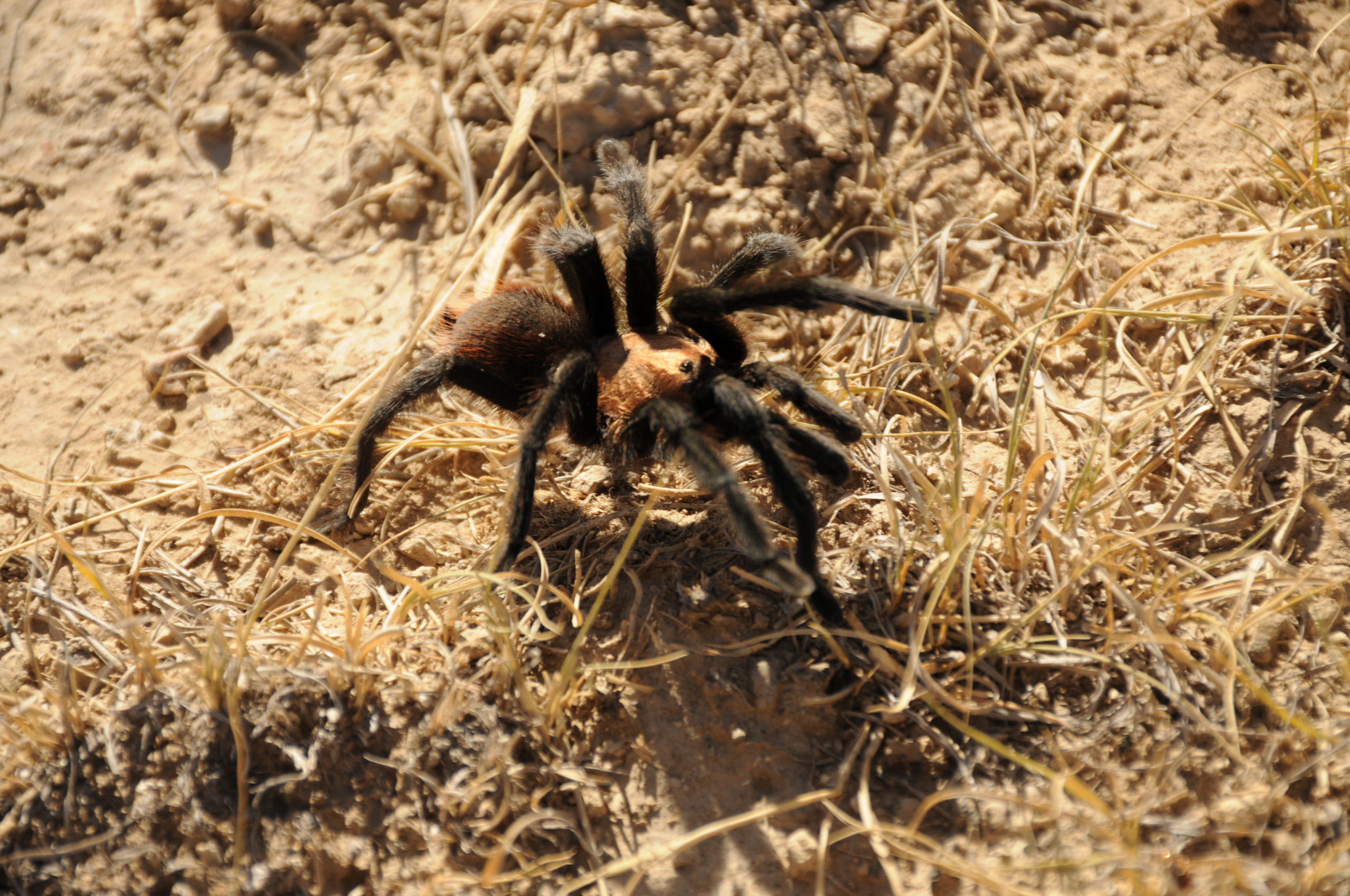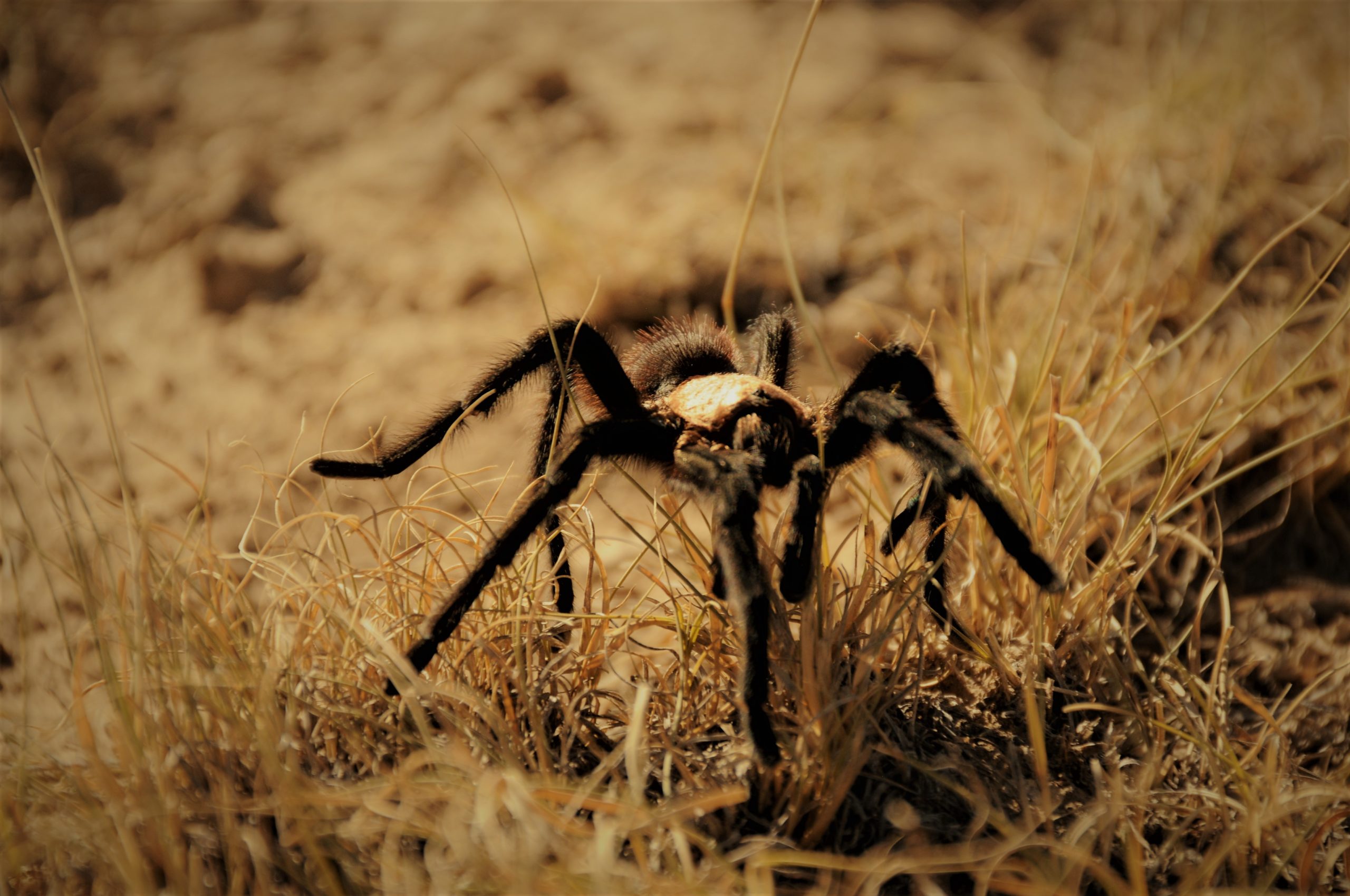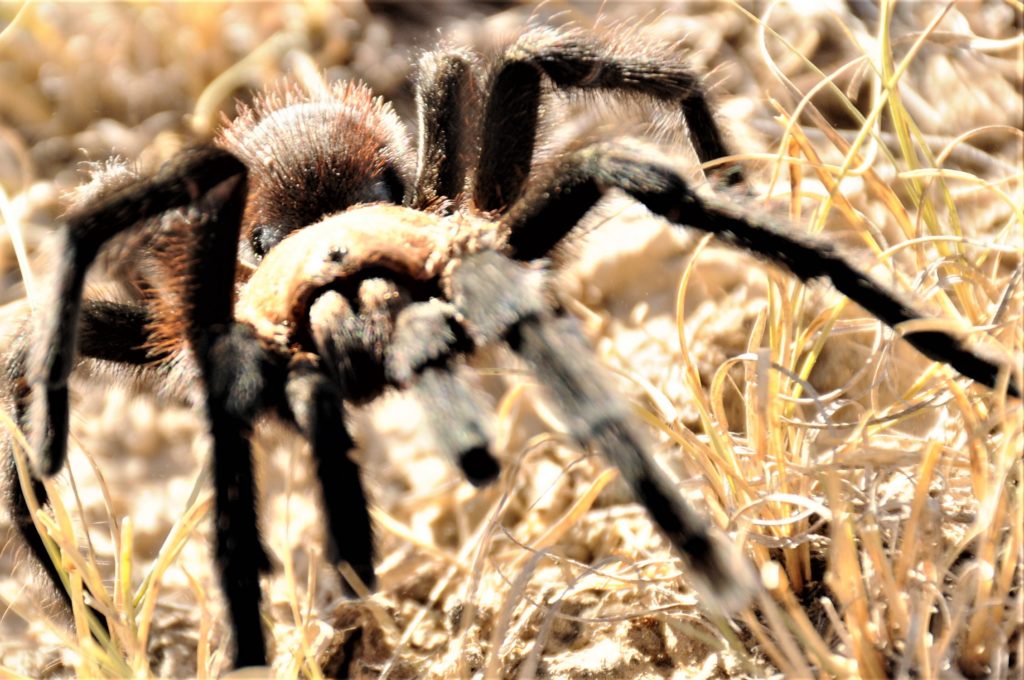Tarantula Trek
A Mating Expedition

Each fall, large numbers of tarantulas skitter across the landscape in La Junta and southeast Colorado. Yes, tarantulas!
While this phenomenon has traditionally been called a migration, it is actually an annual mating ritual performed by male tarantulas who roam across the 443,000-plus acres on the Comanche National Grassland looking to mate.
While there are numerous species of tarantulas, you are likely to spot the Oklahoma Brown Tarantula in La Junta.
This dark brown to black species of the genus Aphonopelma is common here because its females prefer to make their burrows in the plentiful undisturbed prairies on the Comanche National Grassland of Southeast Colorado. Once these females have made their burrows, they tend to stick close to them for the entirety of their lives, which can be 25 years long.
Whether you have a few hours, a few days, or a few weeks, explore a few of the suggested travel ideas and itineraries of things to do in La Junta.
Quick Viewing Tips
- September is the ideal time of year to view the tarantulas.
- There may still be activity in October and November.
- Venture out on a day that is warm, and preferably not too windy.
- Some tarantulas may be active in the late afternoon.
- The ideal viewing time is in the hour before sunset.
- Venture out around 5:45 pm to 6:00 pm.
- Peak viewing lasts about an hour.
- Scout areas where there are tarantula hawks—the spider hunting wasps that prey on tarantulas.
- An ideal viewing location is south of La Junta on Highway 109 on the Comanche National Grassland.
- Be aware of cars and trucks traveling the road at all times.
- Pull as far off the roadway as possible or find a turnout or intersection to view the tarantulas.
Viewing Tips
The best time to view tarantulas is an hour before dusk during mid-September thru October and even into early November—depending on the weather. Because these spiders prefer undisturbed lands to nest, the vast and beautiful prairies on the Comanche National Grassland make ideal habitats.
Best time of year to look for tarantulas
- The mating season starts once the temperatures cool at night, which is typically around the start of September, making September the ideal time of year to view the tarantulas as they seek a mate.
- This phenomenon continues through October or whenever hard freezes begin, sometimes into early November.
- Venture out on a day that is warm and preferably not too windy.
Best time of day to spot tarantulas
- Some tarantulas are active in the late afternoon, though things really pick up in the hour before sunset, making 5:45 pm to 6 pm the best time to start looking.
- Expect this peak to last about an hour.
Best places to see tarantulas
- Ideal viewing is south of La Junta on Highway 109 on the Comanche National Grassland.
- Also look for tarantula hawks, the spider hunting wasps that prey on tarantulas.
What should I look for?
You generally will not find tarantulas where people have plowed. They have permanent burrows, which they may inhabit for two decades. During the day, the burrow entrance is often marked with a veil of silk to deter predators, so it has to be an area that hasn’t been destroyed. It has to be a relatively intact, native prairie.
How many tarantulas might I see?
If you have seen headlines about “thousands of tarantulas” or “waves of tarantulas” marching across southeast Colorado every fall, you might have the wrong idea. On the contrary, you might see one, two, or ten crawl across the prairie at a time. Or, you might see none.
Where to Find Tarantulas
Take a Drive
Ideal places to look for those males are south of La Junta on Highways 10, 350, and 109, and county roads in between, an hour or so before sunset. Comanche National Grassland is a good place to spot them as well.
Popular sites include Vogel Canyon (15 miles from La Junta), Sierra Vista & Timpas Picnic Area (about 20 miles from La Junta along Hwy 350), and Delhi (36 miles from La Junta on Hwy 350).
Vogel Canyon is a short drive from La Junta and is always a popular destination because it has something for everyone—from short hikes to quiet picnics. Vogel Canyon Picnic Area has picnic shelters, a vault toilet, and hiking trails with a variety of difficulties and lengths that take you to the mesa top or canyon bottom.
A great driving route to consider is La Junta to Timpas (on HWY 350), east on County Road N, south on County Road 25, east on Forest Service Road 2200, north on HWY 109, and then back to La Junta.
Contact the Comanche National Grassland Resource Office for additional ideal viewing locations in and around La Junta at (719) 384-2181 or info@visitlajunta.net for additional information.
Tarantula Viewing Opportunities
Tarantula Safety
While we love to invite visitors to see the tarantulas in and around La Junta, we ask that you do the tarantulas right by viewing them with care and following these guidelines.
- Do not enter or park on private land for tarantula viewing. Make sure you remain on public land and public roads.
- To be safe, if you see a tarantula, pull as far off the roadway as possible or find a turnout or intersection (note that most of these highways don’t have shoulders).
- Tarantulas may be seen skittering across highways. Please do not stop in the middle of the road to view the tarantulas. It is important to follow all traffic rules and pull over in a safe viewing area where there is ample room for cars to continue on the highway.
- Do not come to an abrupt stop or leave your vehicle in the middle of the road because other watchers may be more focused on the spiders than other vehicles.
- Do not block other roadways.
- Once you have exited your vehicle, it goes without saying to watch both ways for traffic before pursuing a tarantula. Also, make sure you’re on public, not private, property.
- There are various hunting seasons going on during this time of year. Even though most hunters are very safety conscious, it is best not to wear tan and white (the colors of pronghorn). Actually, if you are going to be along roadways, wearing an orange vest is probably a very good idea, so that other drivers can spot you better.
- Please do not aim for the tarantulas and smash them on the highway. They will not attack your tires, jump into your vehicle, or follow you home.
- Take photos if you would like, but let the tarantulas be. Although tarantulas can bite, their venom is not toxic to humans and is comparable to a bee sting. The hairs on their bodies can result in itching, though. They can be hurt if they fall from a distance, such as your hands.
- Be aware of passing traffic while outside of your vehicle. And be sure to keep an eye on any children.
- Please remember that you are the guardian of the unique canyons on the Comanche National Grassland. Rock art, stone tools, charred bones, and rubble from dwellings provide evidence that people thrived on the Comanche National Grassland for thousands of years. Each relic of the past holds a clue that archaeologists use to reconstruct life here long ago. These cultural resources are ancient, fragile, and irreplaceable. If destroyed or removed, the information they reveal is lost forever. And so is a legacy that belongs to us all.
- When on the Comanche National Grassland, please do not touch rock art! Oils from your hands promote deterioration of the drawings and the rock surface. Do not draw or scratch graffiti on rocks or cliff faces. Graffiti defaces a fragile, irreplaceable legacy.

Care for Colorado… and Tarantulas!
Care for Colorado promotes the following principles:
- Know Before You Go
- Stick To Trails
- Leave It As You Find It
- Trash the Trash
- Be Careful With Fire
- Keep Wildlife Wild
- Share Our Parks & Trails
We kindly ask that you practice these while looking for tarantulas. Respect them and their home by Caring for Colorado.
About The Tarantula Trek: A Mating Expedition

While you might have heard of the “tarantula migration,” it is not a migration at all. Rather, it is male tarantulas seeking out a mate, which they start doing when they reach maturity at the age of eight to 10 years old.
Prior to this age, these boys have not left the grassland in southeast Colorado at all but have simply been buying their time until they reach mating age. And though you are likely to spot one at a time, you may be lucky enough to see a group of these males who use their sense of touch and vibration to locate the females.
For the Oklahoma Brown Tarantula, males tend to seek out females from September through October.
Tarantulas are very large, hairy spiders that can be found in the southwestern United States, including southern Colorado. All species found in this area are generally dark brown to black. The tarantula can attain a body length of up to 2 inches and a leg span of up to 5 inches.
Males reach maturity about 7-10 years after egg hatch. They can travel as many as twenty miles and oftentimes are in groups searching for a mature female. Once fertilization has occurred, the female constructs a huge (golf ball-sized) egg sac, to lay her eggs in. She then protects the egg sac from predators and turns it frequently. Hundreds of spiderlings can hatch at a time. Almost all tarantulas that are observed are mature males seeking a mate. Tarantula mating is probably one of the strangest animal reproduction rituals. It is unlike anything else we have seen in the animal realm, and it functions in a completely different way thanks to tarantulas' unusual bodies.
Males who have reached sexual maturity will usually go through an "ultimate" or final molt and "hook out," which means they will have their tibial hooks as well as bulbs at the end of their pedipalps. This is a physical marker of sexual maturity. Therefore, many won't be surprised to find this male tarantula constructing a sperm web in preparation for mating.
At this time, a male tarantula can travel up to a mile to find a mate, and once he finds one, he’ll perform a courtship dance. Certain body language cues and rituals exist, just as they do in many other animals. One of these is "drumming" or "tapping," which a tarantula may use to indicate interest in a potential spouse. For example, a male tarantula may tap his pedipalps or legs on a female's web in a courting setting to determine whether she is interested and alert her to his presence and intent. If she's receptive, she might return the drumming as a signal for him to approach.

Unfortunately, males typically don’t live long after mating. Death by predator, car, or starvation—or rather, lack of interest in eating anything—typically follows. And in some cases, the female may eat the male.
Females, on the other hand, may live for more than two decades, and they rarely leave the vicinity of their burrows. Females are larger than the males and reach maturity between 8 to 10 years. It is not uncommon for females to live over 20 years. However, males rarely live one year past maturity and usually die during or shortly after mating because they are killed by vehicles while crossing the roads or become the victim of predators like tarantula hawk wasps, coyotes, or even female tarantulas.
Tarantula hawks, the spider hunting wasp, prey on tarantulas. These huge wasps (the largest wasps in the United States) feed on nectar but reproduce in a particularly morbid fashion. When a female wasp is ready to lay her eggs, she seeks out a tarantula and injects it with paralyzing venom. She drags the tarantula to a burrow, stuffs it down the hole, then lays her eggs on top of the paralyzed spider. Several days later, the eggs hatch, and the larvae feed on the still-living tarantula.
Annual La Junta Tarantula Fest
Join us for the Annual La Junta Tarantula Fest in Downtown La Junta, the last Friday and Saturday in September. Enjoy a parade, vendors, education pavilion, tarantula tours and much more!
FAQs
Farm Markets
Do not forget to stop by one of the many Farm Markets along Highway 50 when you come to view the tarantulas! Arkansas Valley farmers work hard on their farms all season to grow a wide variety of produce, such as corn, watermelons, cantaloupes, and much more.
Farm Markets are typically open between July and October to the delight of residents and visitors alike seeking the good bounty from this fertile land.
Tarantula Press
Creepy, crawly love: Colorado’s annual tarantula ‘migration’ has begun The Denver Channel | September 7, 2021
Southern Colorado’s notorious tarantula migration is all about looking for love The Gazette | September 30, 2021
Annual Tarantula Migration begins in southern Colorado; where you can see it Fox News 21 | September 9, 2021
Great migration of tarantulas is underway in Colorado
Accuweather.com | September 23, 2021
Tarantulas Head To Colorado For Annual Migration To Mate CBS Denver | September 8, 2021
Colorado’s Annual Great Tarantula Migration is Underway as Mating Season Approaches Nature World News | September 23, 2021
The great tarantula migration is taking place across America’s plains The Denver Channel | October 19, 2021
Thousands of tarantulas have started their march around Colorado Out There Colorado | September 14, 2020
Is that love in the air? Thousands of tarantulas to descend on southeast Colorado in search of mates CNN | August 9, 2019
It’s Tarantula Time Seco News
Tarantulas roam the roads in this town USA Today | October 5, 2015
La Junta Tarantula Migration American Explorer | October 16, 2020
Annual “tarantula crawl” has hairy critters on the move in Colorado The Denver Post | October 20, 2013










